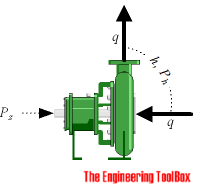Centrifugal Pumps
An introduction to Centrifugal Pumps.
A centrifugal pump converts input power to kinetic energy by accelerating liquid in a revolving device - an impeller.
The most common is the volute pump - where fluid enters the pump through the eye of the impeller which rotates at high speed. The fluid accelerates radially outward from the pump chasing and a vacuum is created at the impellers eye that continuously draws more fluid into the pump.

The energy from the pumps prime mover is transfered to kinetic energy according the Bernoulli Equation. The energy transferred to the liquid corresponds to the velocity at the edge or vane tip of the impeller. The faster the impeller revolves or the bigger the impeller is, the higher will the velocity of the liquid energy transferred to the liquid be. This is described by the Affinity Laws.
Pressure and Head
If the discharge of a centrifugal pump is pointed straight up into the air the fluid will pumped to a certain height - or head - called the shut off head. This maximum head is mainly determined by the outside diameter of the pump's impeller and the speed of the rotating shaft. The head will change as the capacity of the pump is altered.
The kinetic energy of a liquid coming out of an impeller is obstructed by creating a resistance in the flow. The first resistance is created by the pump casing which catches the liquid and slows it down. When the liquid slows down the kinetic energy is converted to pressure energy.
- it is the resistance to the pump's flow that is read on a pressure gauge attached to the discharge line
A pump does not create pressure, it only creates flow. The gauge pressure is a measurement of the resistance to flow.
In fluids the term head is used to measure the kinetic energy which a pump creates. Head is a measurement of the height of the liquid column the pump could create from the kinetic energy the pump gives to the liquid.
- the main reason for using head instead of pressure to measure a centrifugal pump's energy is that the pressure from a pump will change if the specific gravity (weight) of the liquid changes, but the head will not
The pump's performance on any Newtonian fluid can always be described by using the term head.
Different Types of Pump Head
- Total Static Head - Total head when the pump is not running
- Total Dynamic Head (Total System Head) - Total head when the pump is running
- Static Suction Head - Head on the suction side, with pump off, if the head is higher than the pump impeller
- Static Suction Lift - Head on the suction side, with pump off, if the head is lower than the pump impeller
- Static Discharge Head - Head on discharge side of pump with the pump off
- Dynamic Suction Head/Lift - Head on suction side of pump with pump on
- Dynamic Discharge Head - Head on discharge side of pump with pump on
The head is measured in either feet or meters and can be converted to common units for pressure - like psi, Pa or bar.
- it is important to understand that the pump will pump all fluids to the same height if the shaft is turning at the same rpm
The only difference between the fluids is the amount of power it takes to get the shaft to the proper rpm. The higher the specific gravity of the fluid the more power is required.
- Centrifugal Pumps are "constant head machines"
Note that the latter is not a constant pressure machine, since pressure is a function of head and density. The head is constant, even if the density (and therefore pressure) changes.
The head of a pump can be expressed in metric units as:
h = (p2 - p1) / (ρ g) + v22 / (2 g) (1)
where
h = total head developed (m)
p2 = pressure at outlet (N/m2)
p1 = pressure at inlet (N/m2)
ρ = density (kg/m3)
g = acceleration of gravity (9.81) m/s2
v2 = velocity at the outlet (m/s)
Head described in simple terms
- a pump's vertical discharge "pressure-head" is the vertical lift in height - usually measured in feet or m of water - at which a pump can no longer exert enough pressure to move water. At this point, the pump may be said to have reached its "shut-off" head pressure. In the flow curve chart for a pump the "shut-off head" is the point on the graph where the flow rate is zero
Pump Efficiency
Pump efficiency, η (%) is a measure of the efficiency with which the pump transfers useful work to the fluid.
η = Pout / Pin (2)
where
η = efficiency (%)
Pin = power input
Pout = power output



